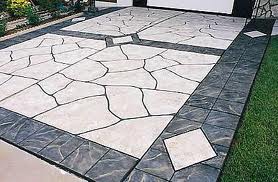
Give worn, drab concrete a complete face-lift. Here’s a primer of the various overlay types and the decorative possibilities with each.
By Anne Balogh, Concrete Network Columnist
Want to permanently cover up surface imperfections in existing concrete? Or turn a plain-jane slab from drab to fab? With today’s decorative overlays, it’s easy to give almost any concrete surface, indoors or out, a complete face-lift and at a much lower cost than removal and replacement. The real challenge is choosing from among the many resurfacing products available and the diverse array of decorative finishes possible. There are multiple options available for achieving any look imaginable with a concrete overlay.
Here’s a primer of the various overlay types available and the decorative options with each. We also give you pointers on how to choose the best system for a particular application. With the many options available, you’re sure to find at least one system that meets your requirements for durability, appearance, maintenance, and cost.
Although cement-based overlays have been around for decades, many of today’s systems blend polymer resins with cement, sand, and other additives to improve performance, wear resistance, and aesthetic qualities. Polymer-modified overlays can be applied in layers as thin as a credit card or up to several inches thick without delamination or failure. They adhere well to existing concrete and resist damage from salt, chemicals, UV exposure, freeze-thaw conditions, and abrasion.

While most types of polymer-modified overlays offer similar performance benefits, each system has its own unique characteristics. Overlay manufacturers use different types of polymer resins, often blending them to produce proprietary products with distinct physical attributes. Many of today’s decorative overlays use acrylics or acrylic blends because these resins provide excellent bond strength and UV resistance.
Before you read any further, though, it’s important to be aware that not all existing concrete can be resurfaced. The underlying base for an overlay must be sound. If your concrete is heaving, has severe cracks, is spalling due to damage from deicing salts and freeze-thaw cycles, or resting on unstable soil, resurfacing will not solve your problems. This is when total replacement will be your best option.
Contact a qualified contractor in the Las Vegas area: www.artconlv.com

Be the first to comment